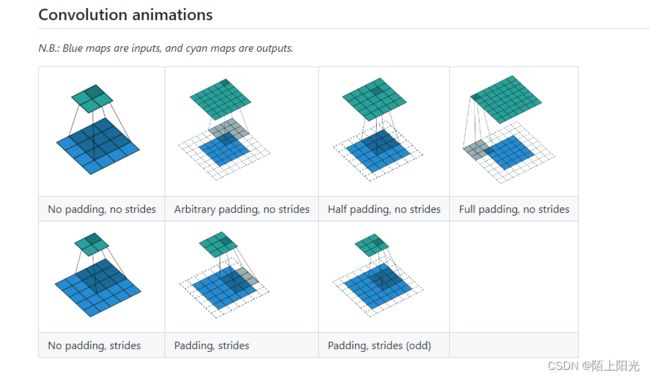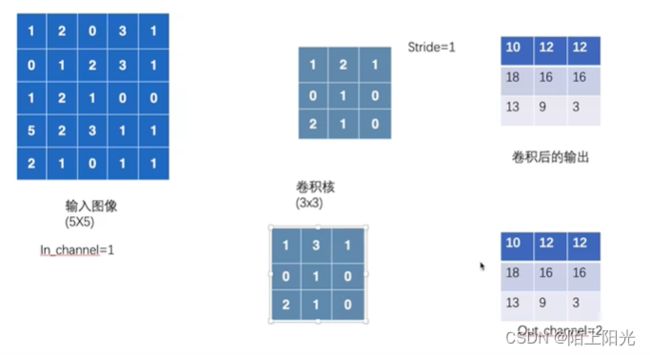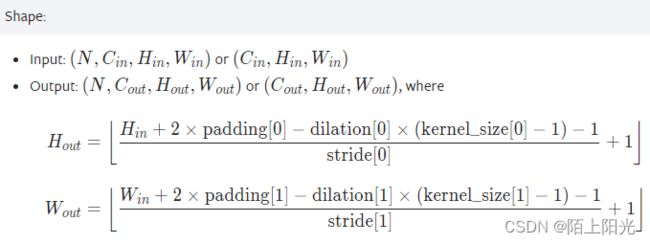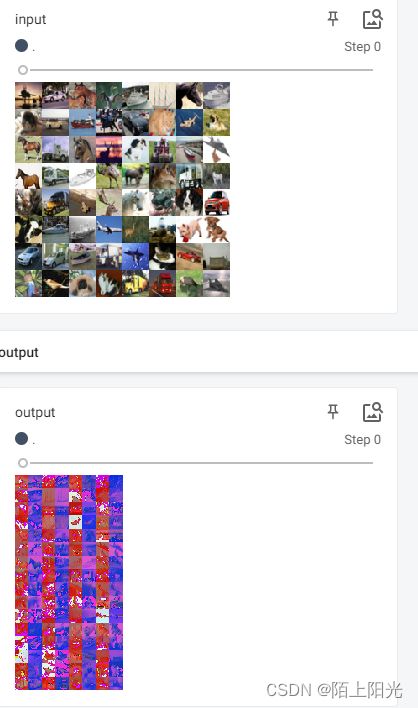学习pytorch9 神经网络-卷积层
神经网络-卷积层
-
- 官网
- 卷积数据公式
- 参数说明
- 卷积运算演示
- 输入输出channel
- 代码
-
- **注意点:**
- code
- 执行结果
官网
https://pytorch.org/docs/stable/nn.html#convolution-layers
图像识别常用conv2d 二维卷积 nn.Conv2d
https://pytorch.org/docs/stable/generated/torch.nn.Conv2d.html#torch.nn.Conv2d
卷积数据公式
参数说明
Parameters:
-
in_channels (int) – Number of channels in the input image 输入通道
-
out_channels (int) – Number of channels produced by the convolution 输出通道
-
kernel_size (int or tuple) – Size of the convolving kernel 卷积核大小
-
stride (int or tuple, optional) – Stride of the convolution. Default: 1 每次卷积走多少步,横向纵向的步径大小
-
padding (int, tuple or str, optional) – Padding added to all four sides of the input. Default: 0 是否在卷积过程中对输入图像的边缘进行填充
-
padding_mode (str, optional) – ‘zeros’, ‘reflect’, ‘replicate’ or ‘circular’. Default: ‘zeros’ 填充数据的模式是什么,默认为zeros,填充的都是0
-
dilation (int or tuple, optional) – Spacing between kernel elements. Default: 1 卷积核中间的距离? 一般不改 不常用
-
groups (int, optional) – Number of blocked connections from input channels to output channels. Default: 1 一般不改 不常用
-
bias (bool, optional) – If True, adds a learnable bias to the output. Default: True 添加偏置值,默认为True添加偏置值

卷积运算演示
https://github.com/vdumoulin/conv_arithmetic/blob/master/README.md
绿色方格:表示输出图像
蓝色方格:表示输入图像
蓝色方格中的深色阴影部分:表示kernel 卷积核
白色虚线:表示padding填充
动画中深色阴影上下左右整体移动的方格数,表示stride的大小

输入输出channel
两个卷积核做两次卷积,叠加输出一起是out_channel=2

代码
注意点:
- super()括号里面没有内容,自动填充的self应该去掉
super().__init__()
code
import torch
import torchvision
from torch import nn
from torch.utils.data import DataLoader
from torch.utils.tensorboard import SummaryWriter
test_set = torchvision.datasets.CIFAR10(root='./dataset', train=False, transform=torchvision.transforms.ToTensor(), download=True)
dataloader = DataLoader(test_set, batch_size=64, shuffle=False)
class NnConv2d(nn.Module):
def __init__(self):
super().__init__()
self.conv1 = nn.Conv2d(in_channels=3, out_channels=6, kernel_size=3, stride=1, padding=0)
def forward(self, x):
x = self.conv1(x)
return x
nnconvd = NnConv2d()
writer = SummaryWriter('./logs')
step = 0
for data in dataloader:
imgs, targets = data
output = nnconvd(imgs)
print(imgs.shape)
print(output.shape)
writer.add_images("input", imgs)
output = output.reshape([-1, 3, 30, 30])
writer.add_images("output", output)
step += 1
执行结果
......
torch.Size([64, 6, 30, 30])
torch.Size([64, 3, 32, 32])
torch.Size([64, 6, 30, 30])
torch.Size([64, 3, 32, 32])
torch.Size([64, 6, 30, 30])
torch.Size([64, 3, 32, 32])
torch.Size([64, 6, 30, 30])
torch.Size([64, 3, 32, 32])
torch.Size([64, 6, 30, 30])
torch.Size([64, 3, 32, 32])
torch.Size([64, 6, 30, 30])
torch.Size([16, 3, 32, 32])
torch.Size([16, 6, 30, 30]) # 最后一个batch16是因为drop_last默认为False,最后没除尽的也要保留,参与训练


